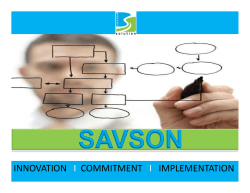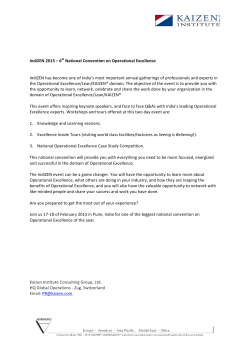
Adaptive IT Innovation - Ground System Architectures Workshop
Adaptive IT Innovation Frank Konieczny AF Chief Technology Officer Office of Information Dominance & Chief Information Officer March 2015 On the Road to Innovation How can the AF effectively integrate new IT technologies into a mission? What processes could be used? Are there tools/patterns to support this? How does this intersect with Joint Information Environment (JIE) planning? INNOVATION Integrity - Service - Excellence 2 INNOVATION Where to Start? Distill current description of the activities that the AF is responsible to accomplish from AF Enterprise Architecture (2010) Determine which Mission Area best represent the Information Environment: IEMA Categorize IT functions supporting the AF mission: Presentation – 5 Enterprise Management – 16 Enterprise Applications – 3 Application Foundation – 10 Data/Information – 13 Computing Services – 9 Storage – 8 Network/communications – 19 Device Ops/Mgmt – 3 Network Ops/Mgmt – 15 Application Ops/Mgmt – 6 Security – 23 Total: 130 Integrity - Service - Excellence 3 INNOVATION How to Approach the Problem? Ask the user community Specify what capabilities/outcomes are desired Frame these in terms of use cases/scenarios/questions Develop Technical Profiles (specifications) to describe technical solutions that resolve the use case issues; use EA identified IT functions as base for technical profiles Enterprise Architecture Functional Issues Use Case Based Scenarios Target Baseline Target Baseline (TB) is future state – drives capability evolution Integrity - Service - Excellence 4 How do Real Products get Delivered? The IT Function Technical Profiles together describe capabilities/products that can be acquired/developed/delivered AFLCMC delivers these capabilities as the Implementation Baseline (IB), and IT capabilities in the Common Computing Environment services catalog Since TB is future state, all TB requirements may not be yet deliverable; plan to attain complete requirements Target Baseline IB Capabilities TB Reqm’ts INNOVATION TB-IB Completion Chart Integrity - Service - Excellence 5 INNOVATION What do I do with these IB Capabilities? Implementation Baseline (IB) provides standardized components/architecture for application usage IB definition is about speed Speed through a more rapidly provisioned accredited environment A consistent environment/patterns for mission capability developers New and modernizing applications are required to use these standard components If additional capabilities are needed, must be Target Baseline compatible or needs to be added through the Target Baseline process App Code Common Computing Environment Application Code Operational Baseline Fielded capabilities are part of the Operational Baseline (OB) – this includes specific infrastructure and application configurations Integrity - Service - Excellence 6 INNOVATION What is all this? A governance process to systematically inject new enterprise level information technologies and infrastructure A set of standards, protocols, requirements and service components to support building current and future state of the IT enterprise Description of the current and future state of the IT enterprise environment Three baselines which are approved by established AF-wide Configuration Control Boards (CCBs) Collectively called the AF Consolidated Enterprise IT (CEIT) Baselines Integrity - Service - Excellence 7 INNOVATION Baselines Reviewed Target Baseline (TB) - specifies the standards, protocols, guidelines and implementation constraints for the future state of the AF IT infrastructure – the “To-Be” infrastructure Implementation Baseline (IB) - the set(s) of acquisition selected products and their configurations that implement the Target Baseline – for new and modernized applications, the instantiation of the target (TB) into an operational application infrastructure Operational Baseline (OB) - the set of components of the IB configured and deployed across the AF IT infrastructure to provide the required warfighter capabilities and performance – the “As-Is” infrastructure Integrity - Service - Excellence 8 INNOVATION CEIT Strategy Separate mission capability from infrastructure Migrate, Build, Use capability on provided IT infrastructure Use services to deliver capability in modular, incremental approach Get out of the business of hosting mission and business systems or applications Procure hosting services from a provider (e.g., DISA, vendors, etc.) Establish and manage infrastructure as a system Based on managed services and commoditized IT Provide standard infrastructure platforms/patterns Adopt standards-based approach Adopt effective processes/approaches/patterns Recognized and supported governance Develop, test & integrate new capability in the operational environment Drive these innovations into the Joint Information Environment initiative IDT Support Operable capabilities Integrity - Service - Excellence 9 INNOVATION Timelines Target Baseline Each major number release has two segment releases: Scenarios and Technical Profiles Goal is 45 working days for the each segment release to the TB CCB Three to four releases during the year Implementation Baseline Tempo of IB releases to keep pace with technologies, greater commoditization, and ultimately more commonality and lower total life-cycle costs There needs to be a level of stability for acquisition and development to be viable similar to commercial development IB 3.0 development focuses on business systems use cases and limited C2 mission systems Mid cycle “dot” releases, e.g., 3.1 Enterprise Services and Managed Platforms, support adjustments and additions prior to next major annual release Operational Baseline As items are fielded Integrity - Service - Excellence 10 INNOVATION User On Ramp: Target Baseline Target Baseline Scenario Workshop Off-site discussions held to determine the topics/use cases of interest from the AF community for the forthcoming releases Open to all AF personnel Selection of final topics collectively made based on estimated workload to be accomplished within the 45 working day window Scenarios/Use Cases not included in the forthcoming release tabled until the next workshop Agility/adaptability maintained by focusing on current issues Out-of-cycle capability review When there is a mismatch between a desired tool and TB capability, we determine if the TB needs to be updated to incorporate the new features Updates will be incorporated in the next TB release Integrity - Service - Excellence 11 User On Ramp: Implementation Baseline INNOVATION SAF/CIO A6 Mission Area Integrators (MAI) MAIs will coordinate with the C3N&I Managed Service Office (MSO) to migrate/modernize your application using the latest IB components. MSO takes MAIs and Acquisition Process requirements as the point for providing capability to user/customers Coordination includes establishing the provisioning of the development, test and production environments. IB Technical Working Group Meeting All Functional Areas invited to participate in IB definition. TB & OB members participate to incorporate consistency, traceability, and executability. Supports identifying and filling gaps. Integrity - Service - Excellence 12 INNOVATION DoD Transformation/Innovation: Joint Information Environment Mission Effectiveness Coalition Forces Increased Security IT Efficiencies Deployed Environment Mission Applications Data Computing “Enterprise Information Environment” APEX Navy ERP AT21 DCO Enterprise Defense Email Travel AFATDS Big Rock Focus Areas Data Computing iEHR Airman Fundamentals Close Combat TM Applications “Enterprise Information Environment” ?? Home Work Mobile (TDY/Deploy) Future devices Network Normalization Data Center Consolidation Single (Cyber) Security Architecture Identity and Access Management Enterprise Services Access at the Point of Need TANK directed development of JIE Way Ahead (16 Dec 11) Integrity - Service - Excellence 13 INNOVATION DoD Transformation/Innovation: Joint Information Environment Internet Access Point Partner Gateway Enterprise Ops Center Data Center Consolidation SATCOM MPLS WAN Core Data Center -- “cloud” capabilities -- Optical Core connectivity -- Tier 3 data center All applications are to move to Core Data Centers (CDC) by FY18 unless mission/cost justification is provided Base data centers are consolidated into Installation Processing Nodes (IPN) Base Base Special Purpose Processing Nodes (SPPN) Special Purpose Processing Node Installation Processing Node -- Contained capabilities -- Essential mission apps Installation Service Node -- Enterprise Services -- No applications Mission-critical applications that must operate in a DIL environment All tenants utilizes the IPN on base Cyber Security Stack for outside base communications Special processing that has no external personnel (i.e., outside of the SPPN facilities) accessing the systems (e.g., hospital) Connectivity to DODIN through the IPN/CDC security stack Integrity - Service - Excellence 14 INNOVATION DoD Transformation/Innovation: Joint Information Environment Network Normalization – Joint Regional Security Stacks (JRSS) Replaces AF Gateway and Base-to-Base network construct Encompasses NIPR/SIPR, SATCOM, Mission Partner Networks,... Integrates cyber security capabilities NIPR JRSS SIPR JRSS PLANNED PROCURED INSTALLED Equipment racked and cabled ACTIVATED Baselined,STIGed, ready for traffic Integrity - Service - Excellence MIGRATED Passing operational traffic 15 INNOVATION Integrity - Service - Excellence 16 Results – Target Baseline Release 1 INNOVATION Summary Use Cases: 1. How to expedite user access to enterprise applications/network resources? More effective and consistent way to maintain and update application and data access controls that would lessen system administrator handling 2. What should we use for migrating to a cloud environment? Standardization of components to establish a virtualized data center and software components that would represent a standard Platform as a Service (PaaS) capability TB Outcomes: 1. Enterprise Level Security (ELS) – Automated method to support application/data access authorizations based on a person’s attributes acquired from authoritative sources, e.g., billet, security clearance, location, completed training 2. PaaS components – standard web/application/database component requirements that comprise a PaaS standard and associated virtualization requirements 3. Virtualization Components – virtualized environment management, hypervisors, communication, virtual storage Integrity - Service - Excellence 17 Results – Implementation Baseline Release 3 INNOVATION Common Computing Environment (CCE) Platforms IB roadmap provides AF Mission Area Integrators with stable standards needed for application planning Today: IB v3.0 w/ Focus on Platform Services; Implements TB Rel 1 Roadmap: IB v3.1 w/Focus on Enterprise Services (e.g. Messaging, Security, etc..) Platform standardization provides AF CCE with the ability to lower cost and improve security Necessary for scalable operations & management Necessary for automation and orchestration IB 3.0 Platforms Microsoft Java Databases • Windows Server 2012 R2 Option 1 • Oracle 11g • Microsoft Internet Information Server (IIS) 8 • Red Hat Enterprise Linux 6.x • Microsoft SQL Server 2012 • JBoss Enterprise Web Server (EWS) • MySQL 5.5 • Microsoft .NET Framework • Red Hat JBoss Enterprise Application Platform (EAP) 6.2 4.5 Option 2 • Red Hat Enterprise Linux 6.x Optional: • SharePoint 2010 • SharePoint 2013 • IBM WebSphere Application Server 7 • IBM HTTP Server Version 7.x (as bundled with WAS AS 7) Option 3 • Red Hat Enterprise Linux 6.x • IBM DB2 Advanced Enterprise Server Edition • [NoSQL DB – Currently Evaluating Options] Access Control • Oracle WebLogic Application Server 11gR1 • Dynamic Attribute Based Access Control • Oracle HTTP Server 11gR1 • Java/.NETt Handlers Integrity - Service - Excellence 18 18 Results: Implementation Baseline Release 3 INNOVATION Increasing Ratio of Value-Added Time to Non-Value-Added Time Type-Accreditation of PaaS services accelerates the application accreditation process through the inheritance of associated security control Case Study: AF SMART application successfully moved to DevOps model with agile, predictable, application releases within DISA MPPS environment Integrity - Service - Excellence 19 Results: TB Rel 1- IB Rel 3.0 INNOVATION Anticipated ROI: More secured applications: automated authorizations More expeditious access: Airmen productive upon arrival Consistent model for PaaS and CNDSP reporting: fewer Airmen needed for maintenance and management activities with increased level of situational awareness C&A inheritance from PaaS/ELS components Status: ELS initial implementation under development in milCloud; Testing with real applications planned in Mar 2015; ATO in Apr 2015 ELS meets JIE DoD IDAM Strategy and Reference Architectures ELS and standard PaaS defined in IB 3.0 AFGM (Sep 2014) mandates the use of the TB 1.0 and IB 3.0 for all new and modernized systems Integrity - Service - Excellence 20 Results: Operational Baseline INNOVATION Automated Asset Inventory Persistent tool set to support inventory sustainment Computing/Storage – Hardware/Virtual USAFE Pilot 10 Base Pilot Application Inventory Configurations – COTS tools/licenses Overlay on asset inventory JIE/FDCCI Influences Consolidation into JIE-specified data centers DoD and Commercial Data Centers AF Base Installation Processing Centers (for critical base mission apps) Integrity - Service - Excellence 21 Results: Target Baseline Release 2 INNOVATION Summary Use Cases: 1. How can network traffic analysis be performed when services, e.g, ELS, requires end-to-end encryption between requester and provider? - Package the application with its own network security services - Perform the network analysis as part of the application package 2. How can applications in milCloud be moved to a commercial provider with minimal configuration change? - Package application along with network security services, managed via configuration files, to facilitate migration between cloud providers TB Outcome: Virtual Application Data Center (VADC): package standard PaaS construct with inherent virtualized network analysis (IDS/IPS), web application firewall and database firewall. Note: each release revisits and improves upon existing Use Cases to accommodate innovation and new guidance Integrity - Service - Excellence 22 INNOVATION Virtual Application Data Center • • • All components virtualized and containerized to a specific application in its own VDC Current trend for security tool is to support a virtual capability – also, accommodates Software Defined Networking (SDN) Security Policies are configured to the criticality of the application Integrity - Service - Excellence 23 INNOVATION Results – TB Release 2 Anticipated ROI: Increased security (built-into the app package) Standardized CNDSP reporting requiring fewer airmen Whitelisted VADC firewall settings requiring less maintenance airmen Capability to move between data centers without app modification; just edit configuration files, requiring fewer Airmen to administer Status: CIO Memo (Feb 2015) mandates the use of the TB 2.0 and IB 3.0 for all new and modernized systems VADC concept being researched by AFRL; support from AFSPC/AFLCMC and DISA for test/evaluation Test pilot application (PAMS) early 2015 Integrity - Service - Excellence 24 INNOVATION TB 1 & 2 Release Synergy Security paradigm shift to defending the mission information at the application layer: Security-Encapsulated Application & Data Enclave (SEADE) Enterprise Level Security (ELS) provides dynamic access control at the application/information layer Virtual Application Data Center (VADC) concept tailors the defense to the application layer Simplifies CND Configured as standard PaaS capabilities with minimal maintenance ELS is a service that is used by applications Anomaly reports are application tagged providing extensive information Can configure to auto-reload if certain anomaly threshold reached User response Effectively eliminates internal DoD domain latency due to network defense appliance saturations Integrity - Service - Excellence 25 INNOVATION Security-Encapsulated Application and Data Enclave (SEADE) Enterprise Attribute Service Secure Token Service Person Claims Generation Person Attribute Management Changes Enterprise Level Request for Security Data/System using Data SAML (claims) Reporting/Logs (to CNDSP/Functional User) App Security Config App Security Configuration Virtual Application Data Center Application Tags Validation DN/EDIPI ( from CAC) Authoritative Attribute Stores/systems (e.g., DMDC, MilPDS) Network Defense/ Analysis Tools Read SAML WAF App Security Config App App Server Web Server App Firewall DB DB Firewall (IDS, DPI, …) Cloud Provider API Abstraction/Interface Layer Bare Metal Type 1 VM Commodity Processors Integrity - Service - Excellence 26 INNOVATION IB 3.1 Incremental point release between major versions Incorporates shift from open PaaS to Managed Platforms Portability to host in DISA DECCs, milCloud, JIE Installation Processing Nodes data centers, other dedicated environments, and secure commercial cloud Incorporates enterprise services as provided by DISA, AF, other Services/Agencies, and commercial providers "as a Service" Provides more ready incorporation of services into a Utility VDC Integrity - Service - Excellence 27 INNOVATION TB Release 3 Summary Use Cases: 1. (Mobility) How do we manage mobile platforms on the enterprise? - Need secure connection to the network over WIFI/4G/LTE - Secure, standard, flexible connections across the aerial, space and terrestrial layers - Standardization of mobile comm capability and device registration across all bases - Use of soft certs for authentication 2. (Enterprise Info Management) How do we perform enterprise search for information? - Making data available enterprise-wide (data tagging) - Capability to find and manage information to support legal and other missions - Capability to restrict access based on information content & need to know 3. (Data Mgmt) How do we manage and integrate data from various sources? - Standard authoritative data source translator - Sensor as a Service Integrity - Service - Excellence 28 Future State of Operator Environment INNOVATION Providing the adaptive environment to include all the equipment, ingredients, and utensils for application developers to satisfy mission requirements. While “under the covers”, the future state: Provides rapid provisioning of infrastructure &tools Better leverages of commercialized technology to support the warfighter Support's agile development of mission software providing user capabilities A fully stocked & instrumented kitchen for chef’s to create their recipes Integrity - Service - Excellence INNOVATION Questions? Integrity - Service - Excellence 30
© Copyright 2025











